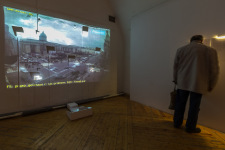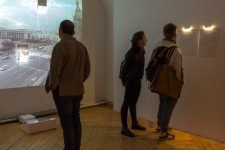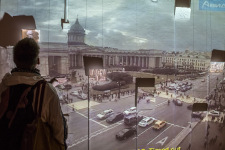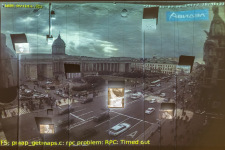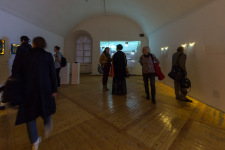by Anna Frants and CYLAND MediaArtLab
Video installation
St. Petersburg, 2017
Nowadays, most people get information from the Internet. The available photos of blockaded Leningrad are sparse and tell a mundane and dry story: corpses on roadsides; a woman pulling a dead child wrapped in a shroud on a sled; people gathering water from holes in the Neva; trolleybuses covered with ice on Nevsky. The emotions are hidden, censored and filtered in the postwar period.
During the blockade years in Leningrad, there was a law prohibiting “photography and filming inside the city”. Very few photographs have been preserved from people’s everyday lives. There are no memorial or family portraits. So the photos from family archives that have been miraculously preserved are especially valuable.
Like all people who were in the blockade, my relatives, who experienced the start of the blockade and evacuation, did not like to talk about what they had to endured. Perhaps they were protecting themselves and realized that people who had not been there would never understand it. Of the few stories they told, I particularly remember descriptions of the evacuation over frozen Lake Ladoga – the Road of Life. Now I understand that they were not stories, but an unforgettable pain that would not go away.
During the blockade, a total of 1.5 million people were evacuated, including my grandmother and my little father, and my mother’s family, along the Road of Life. Not everyone survived. They were lucky. They survived. Now there is me, my sister, my son and my nephews. They will also have children and grandchildren…
“Blind spot” is the name for the section of the road that a driver cannot see. In the installation of the same time, a direct broadcast from web cameras on Nevsky is combined with photographs from a family album. We look at the present-day city in real time, but for us, the understanding of what was experienced by over a million people who died and as many who were evacuated remains invisible. The only “threads of memory” are their words, written in their diaries, rarely remembered stories and a few photographs.
“We were also helped by Uncle Slava’s cousin – the navy sailor Boris Mironov. He brought us black army bread crusts several times, and in the spring of 1942, when we had already lost our grandmother, Maria Fyodorovna Burgova, Boris Nikolaevich Mironov helped us with evacuation across Lake Ladoga along the Road of Life, to the North Caucasus.
It was in Lermontov’s former haunts that the Leningraders were fed and treated, so they could then be sent to their final destination of evacuation. The Institute of cinema engineers was moved to old Samarkand, and the Lenfilm studio (like Mosfilm and other studios) was moved to Alma-Ata in Kazakhstan.
The journey had everything: terrible cold, a risky car race across the melting ice of Lake Lago, and then diarrhea from starvation – outside the blockade ring. We were transported in heated freight cars. I slept in the top bunk, and Mama, Aunt Mika and Uncle Slava slept below. At a railway station in Belorussia, Uncle Slava went as usual to exchange clothes for sour milk and bread. I was asleep. But I still thought I could hear Mama calling me. When I woke up and went down to her bunk, she was already dead.”
From the memoirs of my uncle Vyacheslav Eduarovich Volk
Then Aunt Mika also died during the journey (Lyudmila Alexeevna Burgova). Only 10-year-old Slava and my grandfather, Vyacheslav Alexeevich Burgov, made it to Samarkand.

Participation in Exhibitions:
2017, “Quiet Voices” exhibition, State Museum of the History of Saint Petersburg, Russia.


